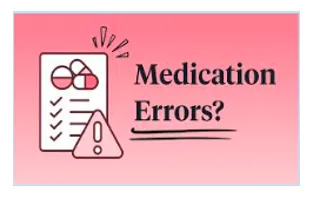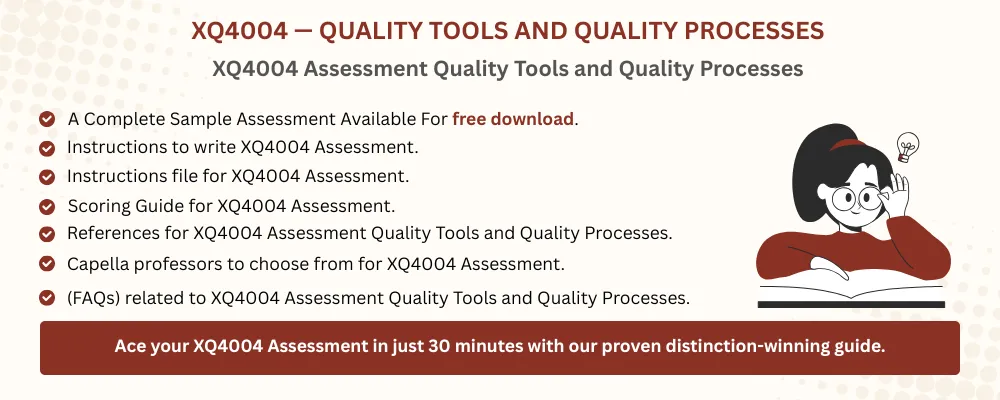XQ4004 Assessment Quality Tools and Quality Processes FREE DOWNLOAD
XQ4004 Assessment
Quality Tools and Quality Processes
Student Name
Walden University
XQ4004
Professor Name
Date
What is PDSA?
The Plan–Do–Study–Act (PDSA) model is a systematic, cyclical approach used in healthcare to test and implement changes that improve quality and safety (Chen et al., 2020). It allows professionals to test interventions on a small scale, study their effectiveness, and adjust before wide-scale rollout. This method supports continuous, data-informed improvements tailored to specific challenges.
The Four Steps of PDSA
PLAN
Identify a specific goal or problem and develop a change aimed at improvement.
Example: The nursing team identifies a high rate of medication errors on the night shift and sets a goal to reduce those errors by 30% in the next month.
DO
Implement the proposed change on a small scale and collect data.
Example: A pilot team of nurses begins using a barcode scanning system and a two-nurse verification process for high-risk medications.
STUDY
Examine the collected data to determine whether the change led to improvement.
Example: After two weeks, error reports drop by 40%. Nurses also report increased confidence and fewer interruptions during med passes.
ACT
Based on the results, decide to adopt the change, adjust it, or abandon it.
Example: The unit decides to roll out the barcode and double-check system across all shifts, with minor adjustments based on nurse feedback.

Why PDSA Works for Medication Safety
- Encourages staff-driven improvements through collaboration (Ho & Burger, 2020).
- Allows flexibility to test and refine solutions before full implementation.
- Promotes a culture of safety by focusing on learning, not blame.
- Builds confidence in change through measurable results.
Medication Errors During Night Shift
Setting: A general medical-surgical ward.
Issue: Repeated medication errors, particularly during late-night hours.
Contributing Factors: Staff fatigue, interruptions, lack of verification process, and outdated equipment.
verification process, and outdated equipment.
Solution via PDSA Cycle:
- Plan: Identify root causes through staff surveys and incident reports.
- Do: Introduce barcode scanners and a mandatory double-check protocol for one shift.
- Study: Measure error rates and gather feedback from pilot group.
- Act: Expand intervention to all units, integrate refresher training, and revise policy.
Outcome:
- 40% reduction in errors.
- Improved workflow and staff morale.
- Foundation laid for further safety initiatives using PDSA.
Benefits of Using PDSA in Healthcare
- Improves patient safety and clinical outcomes.
- Enhances staff ownership and teamwork (Abuzied et al., 2023).
- Supports ongoing learning through short cycles.
- Provides a simple, repeatable method for tackling complex problems.

Instructions To Write XQ4004 Assessment Quality Tools and Quality Processes
Need instructions for this assessment? Contact us now and get expert guidance right away!
Instructions File For XQ4004 Assessment
XQ4004: Quality Tools and Quality Processes
Learning Resources
Discussions
Assessment
My Progress
Walden Resources
XQ4004 Assessment Instructions
Review the details of your assessment including the rubric. You will have the ability to submit the assessment once you submit your required pre-assessment and engage with your Faculty in a substantive way about the competency.
Overview
For this Performance Task Assessment, you will complete a two-part assessment to explain a quality improvement model or process and explain the use in a specific setting.
Instructions
To complete this Assessment, do the following:
- Be sure to adhere to the indicated assignment length.
- Download the Fishbone Template.
Before submitting your Assessment, carefully review the rubric. This is the same rubric the faculty will use to evaluate your submission and it provides detailed criteria describing how to achieve or master the Competency. Many students find that understanding the requirements of the Assessment and the rubric criteria help them direct their focus and use their time most productively.
- Important Information on Interpreting the Assessment Rubric (click to expand)
Rubric
All submissions must follow the conventions of scholarly writing. Properly formatted APA citations and references must be provided where appropriate. Submissions that do not meet these expectations will be returned without scoring.
This Assessment requires submission of two files, a completed infographic, and a completed Fishbone Template. Save the infographic file as XQ4004Infographic_firstinitial_lastname (for example, XQ4004Infographic_J_Smith). Save the Fishbone template as XQ4004Fishbone_firstinitial_lastname (for example, XQ4004Fishbone_J_Smith).
You may submit a draft of your assignment to the Turnitin Draft Check area to check for authenticity. When you are ready to upload your completed Assessment, use the Assessment tab on the top navigation menu.
Important Note: As a student taking this Competency, you agree that you may be required to submit your Assessment for textual similarity review to Turnitin.com for the detection of plagiarism. All submitted Assessment materials will be included as source documents in the Turnitin.com reference database solely for the purpose of detecting plagiarism of such materials. Use of the Turnitin.com service is subject to the Usage Policy posted on the Turnitin.com site.
PART 1: INFOGRAPHIC
- Construct an infographic that focuses on a quality improvement initiative by selecting one of the following quality improvement process or model: Six Sigma, FADE, or PDSA.
- In your infographic, you will describe the quality improvement model or process and incorporate an example to illustrate how the chosen model/process can be applied in your area of practice, our responses, assess yourself using the rubric provided. Use your Pre-Assessment submission and any feedback you may garner to improve and refine your responses.
PART 2: FISHBONE TEMPLATE
Complete the fishbone template to diagram how quality improvement tools might help you to solve problems in your practice.
Submission Length: Two-part assessment: 1) Infographic and 2) Fishbone template.
Rubrics for XQ4004 Quality Tools and Quality Processes
XQ4004: Quality Tools and Quality Processes
Analyze quality improvement methods, strategies, and quality tools to improve patient care outcomes.
Assessment Rubric
Rubric Criteria | Exceeds Expectations | Meets Expectations | Does Not Meet Expectations |
Module 1: Quality Improvement Tools |
|
|
|
Create an Infographic. | The infographic comprehensively and clearly defines and explains the process or model. | The infographic defines and explains the process or model. | The infographic inaccurately and vaguely defines and explains the process or model, or it is missing. |
• Construct an infographic on a specific quality improvement process or model. |
|
|
|
Learning Objective 1.1: Compare quality improvement methods in the delivery of patient care | The infographic includes relevant, specific, and appropriate examples that fully support the explanation. | The infographic includes relevant, specific, and appropriate examples that support the explanation. | The infographic includes inaccurate and vague examples that do not support the explanation, or it is missing. |
Learning Objective 2.2: Describe how quality tools can be used throughout a quality improvement project |
|
|
|
Module 2: Quality Improvement Process |
|
|
|
Complete the Fishbone template. | The response comprehensively and clearly identifies a problem. | The response identifies a problem. | The response inaccurately and vaguely identifies a problem, or it is missing. |
• Identified a problem. |
|
|
|
Learning Objective 1.2: Identify strategies to improve outcomes of patient care in practice |
|
|
|
Rubric Criteria | Exceeds Expectations | Meets Expectations | Does Not Meet Expectations |
• Identified policies and procedures that may affect the problem. | The response comprehensively and clearly identifies problems and procedures that may affect the problem. | The response identifies problems and procedures that may affect the problem. | The response inaccurately and vaguely identifies problems and procedures that may affect the problem, or it is missing. |
Learning Objective 1.3: Compare quality improvement methods in the delivery of patient care |
|
|
|
Learning Objective 2.3: Describe how quality improvement tools are used to improve patient safety |
|
|
|
• Listed all factors related to materials. | The response comprehensively and clearly identifies all factors related to materials. | The response identifies factors related to materials. | The response inaccurately and vaguely identifies factors related to materials, or it is missing. |
Learning Objective 2.1: Compare quality improvement tools |
|
|
|
• Listed all people factors. | The response comprehensively and clearly identifies all factors related to people. | The response identifies factors related to people. | The response inaccurately and vaguely identifies factors related to people, or it is missing. |
Learning Objective 2.1: Compare quality improvement tools |
|
|
|
• Listed all equipment factors. | The response comprehensively and clearly identifies all factors related to equipment. | The response identifies factors related to equipment. | The response inaccurately and vaguely identifies factors related to equipment, or it is missing. |
Professional Writing Skills Assessment
Professional Writing | Exceeds Expectations | Meets Expectations | Does Not Meet Expectations |
Context, Organization, Audience, Purpose, Tone, Style, Clarity, Flow | Demonstrates full awareness of writing context, audience, and purpose. Content is consistently clear, logical, and well organized with appropriate sentence and paragraph structure. Tone is highly professional, scholarly, and free of bias. Style is consistently appropriate for a professional setting/workplace context. Free of spelling, punctuation, and grammar/syntax errors. | Demonstrates some awareness of writing context, audience, and purpose. Content is mostly clear, logical, and well organized with adequate sentence and paragraph structure. Tone is adequately professional, scholarly, and/or free of bias. Style is mostly appropriate for a professional setting/workplace context. Contains few spelling, punctuation, and/or grammar/syntax errors. | Demonstrates minimal awareness of writing context, audience, and purpose. Content lacks clarity, logic, and/or discernible organization and does not use proper sentence and paragraph structure. Tone is not professional/scholarly and/or contains bias. Style is inconsistent with a professional setting/workplace context. Content contains significant spelling, punctuation, and/or grammar/syntax errors. |
Originality, Source Credibility, and Attribution of Ideas | Writing fully reflects original thought and paraphrasing and adheres to reference requirements, including the use of credible evidence to support a claim while incorporating appropriate citations and references in APA format. | Writing adequately reflects original thought and paraphrasing and adheres to reference requirements, including the use of credible evidence to support a claim while incorporating appropriate citations and references in APA format. | Writing does not reflect original thought and paraphrasing and does not adhere to reference requirements, including the use of credible evidence to support a claim while incorporating appropriate citations and references in APA format. |
References For XQ4004 Assessment Quality Tools and Quality Processes
Abuzied, Y., Alshammary, S. A., Alhalahlah, T., & Somduth, S. (2023). Using FOCUS-PDSA Quality Improvement Methodology Model in Healthcare: Process and Outcomes. Global Journal on Quality and Safety in Healthcare, 6(2), 70–72. https://doi.org/10.36401/jqsh-22-19
Chen, Y., VanderLaan, P. A., & Heher, Y. K. (2020). Using the model for improvement and plan-do-study-act to effect SMART change and advance quality. Cancer Cytopathology, 129(1), 9–14. https://doi.org/10.1002/cncy.22319
Ho, J., & Burger, D. (2020). Improving medication safety practice at a community hospital: a focus on bar code medication administration scanning and pain reassessment. BMJ Open Quality, 9(3). https://doi.org/10.1136/bmjoq-2020-000987
Best Professors To Choose From For XQ4004 Class
- Dr. Robert McWhirt
- Dr. Lori Wichman
- Dr. Tracy Wilson
- Dr. Christine Frazer
- Dr. Deborah Terry
(FAQs) related to XQ4004 Assessment Quality Tools and Quality Processes
Question 1: From where to download a free sample for XQ4004-Assessment Quality Tools and Quality Processes?
Answer 1: Download a free sample for this assessment from Tutors Academy.
Question 2: From where to get a instructions and rubrics for this assessment XQ4004-Assessment Quality Tools and Quality Processes?
Answer 2: You can get the rubrics and instructions file directly from Tutors Academy website.
Question 3: What is the XQ4004 Assessment: Quality Tools and Quality Processes at Walden University?
Answer 3: The XQ4004 Assessment focuses on analyzing quality improvement methods, strategies, and tools used in healthcare to enhance patient care outcomes.
Do you need a tutor to help with this paper for you with in 24 hours.
- 0% Plagiarised
- 0% AI
- Distinguish grades guarantee
- 24 hour delivery

